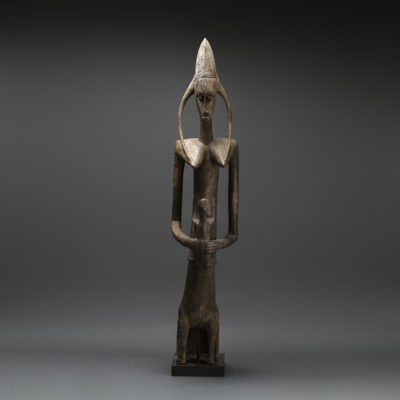
| SKU | PF.3066 |
|---|---|
| Circa | 19th Century |
| Dimensions | 61.5″ (156.2cm) high x 12″ (30.5cm) wide |
| Medium | Wood |
| Origin | Central Mali |
| Gallery Location | S Korea |
This outstanding sculpture is a supreme masterwork of the Bambara/Bamana group of Mali, and the finest such piece that we have ever seen. It is a Guandousou queen figure of exceptional size and quality, portraying a female figure with a very long torso, seated upon a stool and holding a child to her abdomen. The body slims from the hips to the shoulders, which are combined with the smoothly conical breasts into a single unit that is reminiscent of Dogon pieces. The neck is very long and slender, supporting a very refined, graceful head with a pointed chin, a high brow and a very tall, crested coiffure. The eyes are almond- shaped, the nose elongated and the mouth small and pursed, right at the apex of the chin. The incised band at the apex of the forehead gives rise to three slender sections of hair that hang down the nape of the neck, and forwards symmetrically onto each breast. The arms are long and slender, pointing forward to hold the child in position, and decorated with five engraved lines denoting armlets � on the right bicep (there are the remains of lines faintly visible on the left side). The child is grasping its mother, and looking to the sculpture’s left. The surface is weathered and patinated with repeated handling and perhaps the application of pale- coloured libations. The legs are extremely short, and, along with the legs of the stool, weathered through either being buried, or perhaps through insect action (now halted). The identity of the person portrayed is uncertain, but it is clearly an elite personage judging from the jewellery, stool and the extreme care not to mention talent � that the carver has expressed in its execution.
The Bambara/Bamana is one of the largest groups in Mali (about 2.5 million) and lives in a savannah grassland area that contrasts strongly with the Dogon heartland. Their linguistic heritage indicates that they are part of the Mande group, although their origins go back perhaps as far as 1500 BC in the present-day Sahara (i.e. Tichitt). They gave rise to the Bozo, who founded Djenne in an area subsequently overrun by the Soninke Mande (<1100 AD). Their last empire the Mande- speaking Songhai dissolved in the 1600s, and many Mande speakers spread out along the Nigeria River Basin. The Bamana empire arose from these remnant populations in around 1740. The height of its imperial strength was reached in the 1780s under the rule of N�golo Diarra, who expanded their territory considerably. However, their influence waned in the 19th century and the empire fell to the French in 1892. Their society is Mande-like overall, with patrilineal descent and a nobility/vassal caste system that is further divided into numerous subvariants of the Bamana state, including the Jula (traders), Fula (cattle herding), Bozo (essentially endentured slaves, carrying out menial jobs) and Maraka (rich merchant class). Unusual jobs are rewarded with caste status, notably historians (Griot), while those whose ancestors were originally slaves to the Bamana (Jongo) have inherited their antecedents low status. Age, sex and occupation groups are classed by �ton� � societies that reflect their social importance (age- or sex-related) or work (i.e. hunters, farmers). This complex history is echoed in the systematics of indigenous art traditions. There are four main mask forms, related to the n�tomo, Komo, Nama and Kore societies. Other forms include the famous Chi-Wara headcrest, which was used to encourage good harvests. Heavily encrusted zoomorphic �Boli� figures are also known, along with everyday items include iron staffs, wooden puppets and equestrian figures, which double as accessories for male initiation ceremonies. Their anthropomorphic door locks are especially well- known, and are given to women as wedding presents as they imply fertility with a vertical female body and the �male� bar which slides back and forth. The Guan society is responsible for the maintenance and use of most sculptural forms, notably the Guandousou �queen� and the knife- bearing �Guantigui� statues. They are usually exceptionally refined and tranquil pieces, contrasting strongly with the rather more dynamic but less linear �Dyonyeni� forms, made by the Dyo or Kwore societies, usually representing hermaphrodites with large, conical breasts. Old Guandousou are uncommon, and this is the oldest, best-preserved and most skilfully-rendered such piece that we have ever seen. This would be the star of any serious collection of African masterworks.
Login to view price
Sign-up to receive the latest Wedding Estates news and promotions!

